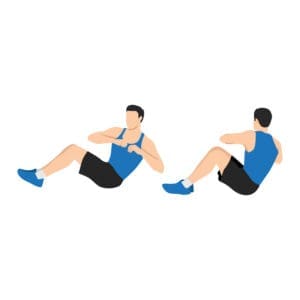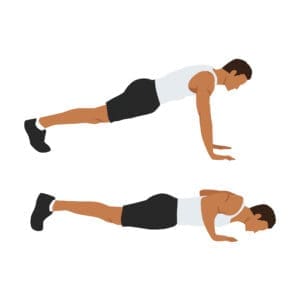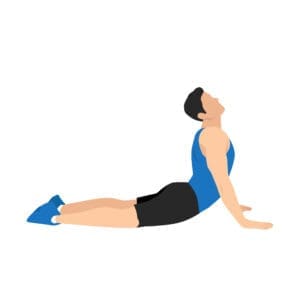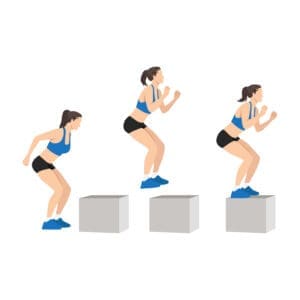
The Best Exercises to Prepare for Skiing
It’s happening! We’re waking up to a slight chill in the air. The days are getting just a little bit shorter. Summer is winding down. What does it all mean? It means it’s time to start thinking about ski season. We know; we still have all of the beauty of fall to enjoy before the snow starts to fly, but conditioning our bodies for the physical demands of skiing and riding is a great use of the shoulder season. Here are some exercises to prepare for skiing so you’re ready to hit the hill as soon as the mountain opens or the family ski trip is on the books.
Strength Training
Leg and core strength are essential aspects of a successful ski season. Incorporate select strength-training exercises into your fall routine to help stabilize your body on the slopes and be able to ski or ride bell-to-bell.
Leg Muscles

Squats
Squats are an excellent way to work many of the major muscles in the lower body as well as the core. This simple exercise has plenty of benefits, including helping with balance, upping your athletic game, and increasing bone density.
- Stand with your feet shoulder-width apart and toes slightly angled to the outside of the knee.
- Keep your back straight while you lower your body by bending the hips and knees, similar to how you would sit straight down in a chair.
- Maintain a straight back throughout the entire motion, and make sure your chest is up.
- Lower until your thighs are parallel to the ground, or even slightly lower for more of a challenge.
- Push back up through your heels until you’ve returned to a standing position.
- Throughout the exercise, be mindful that your knees stay over your toes and don’t extend beyond them and that your weight is evenly distributed to both feet. Also pay attention to your core, keeping it engaged as you lower and raise.
Lunges
Lunges are another excellent way to prep your body for skiing and help reduce the risk of injury, and one you can easily do at home or in the park. The lunge works your quads, glutes, hamstrings, calves, and core muscles.
- To do a proper lunge, start in a standing position with your feet under your hips.
- Take a large step forward setting one leg behind and one leg out in front of your torso.
- Keep the front foot flat and let the back heel rise as you lower while keeping your torso upright and your core engaged.
- Make sure your lead knee doesn’t go past your toes as you lower, and your rear knee should not touch the ground.

Deadlifts
Deadlifts typically require some sort of weight or barbell. If you can’t make it to the gym, simple hand weights can replace a large barbell or other weight apparatus. Deadlifts are an effective all-body exercise that activates the legs, back, core, and arms.
- Work through the deadlift movement without weight first.
- Stand with your feet about hips-width apart. If you’re using a barbell, make sure your feet are under the bar at about mid-foot.
- Bend and grab the bar or hand weights at shoulder-width. Keep your back straight throughout.
- Bend your knees into a squatting position, or until your shins touch the bar if using a barbell.
- Lift your chest and straighten your lower back while you push through your feet to stand up with the weight.
- Pause at the top with the weight, holding for a few seconds with locked knees and hips.
- Return the weight to the floor by reversing the motion.
Core Strength

Planks
Planks are one of the best full-body conditioning exercises you can do. They’re also an excellent gauge of your current body strength.
- On a yoga mat or non-slip floor, start on your hands and knees with your wrists aligned under your shoulders. Focus on a point about one foot in front of you to maintain proper spine alignment.
- Extend one leg back with toes flexed under you, and then the other leg so your weight is fully supported by your hands and toes.
- Activate your core muscles to hold your body in a still position. Fire your abs and draw your navel up toward the ceiling.
- Start by aiming for 20 seconds, and then work your way up to 60-second holds over time, breathing throughout the exercise.
- Rest and repeat.

Russian Twists
Russian twists are another excellent way to build core strength, and easy to do at home.
- Sit with your knees bent out in front of you with your feet flexed and heels on the floor like you’re preparing to do a sit-up.
- With your hands in front of you, lean your torso back until you feel your core muscles start to engage.
- Slowly twist your upper body from right to left, turning your head from side to side as you work through the exercise.
Upper Body
Push-ups
 Push-ups are a great way to work both your core and arm muscles.
Push-ups are a great way to work both your core and arm muscles.
- Start in a plank position with your hands on the ground beneath your shoulders and your legs extended behind you with your feet about hip-distance apart.
- Activate your core muscles and lower your upper body with control by bending your body toward the ground. Keep your elbows from pointing directly to the side or behind you, letting them bend at about a 45-degree angle.
- Work to keep your body moving as a unit, not letting your knees or arms collapse.
- Lower as far as you can go while keeping your body in a plank position. If you can lower your chest to the ground and then push up while maintaining the plank position, go for it. If that’s too far, go as low as you can while still being able to push back up.
- Pause at the bottom and then press through your palms to straighten your arms, working to keep your muscles active and not letting your body sag.
- Do two to three sets of as many reps as you can two or three times per week as a part of your ski conditioning.
Pull-ups
 Pull-ups can be a challenge if you haven’t done them for a while but they offer a great opportunity to develop core and upper body strength while also giving you something to work toward.
Pull-ups can be a challenge if you haven’t done them for a while but they offer a great opportunity to develop core and upper body strength while also giving you something to work toward.
- Stand directly below a safe and sturdy pull-up bar with your hands in an overheard grip (palms facing away). Your hands should be slightly beyond shoulder width apart.
- Grab the bar and activate your core muscles.
- Bend your elbows as you pull your body up toward the bar. Work to get your chin over the bar and pull your body until your collarbone is even with the bar.
- Try to keep your legs and lower body still and your shoulder blades back and down.
- Lower your body in a slow, controlled motion.
- Repeat.
Cardiovascular Endurance
 It’s a good idea to complement your ski or snowboard strength training with cardio. Building up your cardiovascular endurance before ski season will make those first laps much easier. Options include running, jogging, hiking, cycling, swimming, and rowing. Pepper some high-intensity interval training (HIIT) into your routine.
It’s a good idea to complement your ski or snowboard strength training with cardio. Building up your cardiovascular endurance before ski season will make those first laps much easier. Options include running, jogging, hiking, cycling, swimming, and rowing. Pepper some high-intensity interval training (HIIT) into your routine.
HIIT is an interval training exercise that alternates between high intensity movement followed by short periods of lower intensity movements. Sprints or fast-paced aerobic exercise are good examples. To keep it easy and attainable, try sprinting outdoors or on a treadmill for a short distance followed by small rest periods, pulling hard on a rowing machine, sprinting on a stationary bike or trainer, dancing, swimming sprint laps, or pushing yourself on a stair climber. Use a stopwatch or simply sprint for the length of one song and then rest, repeating the series. HIIT offers many benefits, including decreasing body fat and increasing strength and endurance.
Flexibility and Mobility
When the powder gets deep or fresh corduroy calls, it’s important to be ready, nimble, and limber. Flexibility and mobility are important aspects of staying on top of your skiing game. Add these flexibility practices to your ski conditioning routine.
Dynamic Stretching
 Dynamic stretching is active, meaning you’re stretching your body while your joints and muscles move through a full range of motion. This whole-body approach mimics the sport on which you’re focussing and elevates your heart rate. It prepares your body for exercise, gets the blood flowing, improves performance, and contributes to joint health. Examples include:
Dynamic stretching is active, meaning you’re stretching your body while your joints and muscles move through a full range of motion. This whole-body approach mimics the sport on which you’re focussing and elevates your heart rate. It prepares your body for exercise, gets the blood flowing, improves performance, and contributes to joint health. Examples include:
- Jumping jacks
- Hip openers
- Inch worm
- Walking lunges
- High knees
- Leg swings
- Butt kicks
- Torso twist
- Side lunges
- Arm circles
Static Stretching
 Static stretching is what we think of when we think about stretching before or after an activity. This type of body prep requires you to stretch and hold muscle-specific movements. Good static stretches for skiing are:
Static stretching is what we think of when we think about stretching before or after an activity. This type of body prep requires you to stretch and hold muscle-specific movements. Good static stretches for skiing are:
- Hamstring stretch
- Figure 4 stretch
- Quad stretch
- Standing calf stretch
- Side stretch
- Toe touch
- Arm stretches
Yoga
 Yoga has become a favorite of snow sports enthusiasts for its restorative properties and stretch-strength elements. You don’t need a studio to add some yoga to your life; just a mat or non-slip surface. There are a variety of online videos that can walk you through exercises, or, if you prefer in-person learning, check out the yoga studios and classes in your area. It can be a great way to après after a day on the slopes.
Yoga has become a favorite of snow sports enthusiasts for its restorative properties and stretch-strength elements. You don’t need a studio to add some yoga to your life; just a mat or non-slip surface. There are a variety of online videos that can walk you through exercises, or, if you prefer in-person learning, check out the yoga studios and classes in your area. It can be a great way to après after a day on the slopes.
Balance and Coordination
 Dynamic movement and balance exercises mirror many of the same actions we take when we’re on the hill. Doing these as you gear up for winter is an important way to up your balance and coordination, helping prevent injury and increase reaction time. Common ski-prep balance and coordination drills include:
Dynamic movement and balance exercises mirror many of the same actions we take when we’re on the hill. Doing these as you gear up for winter is an important way to up your balance and coordination, helping prevent injury and increase reaction time. Common ski-prep balance and coordination drills include:
- Single-leg stands – Standing on one leg, find a focal point 10 to 20 feet away. Work to stand on one leg without falling for 30 seconds at a time. Switch.
- Bosu Ball exercises – Bosu balls are a staple of any gym. They’re the half-circle balance balls that offer an easy way to add balance to a variety of exercises.
- Agility ladder drills – Using a long rope ladder as your guide, work to hop from one square to the next in a variety of ways, including single-leg hops, double-leg hops, side to side, crossover, straddle, and in-in-out-out.
- Cone drills – Similar to agility drills with a ladder, cone drills are a great way to get in shape for skiing because they require your body to move quickly from side to side.
Ski-specific Drills
 Mimicking ski movements is one of the most important things you can do to get ready for the upcoming season. Skiing and snowboarding are dynamic sports that frequently require a series of quick-response, side-to-side movements. Add the following plyometric drills to your conditioning routine to maximize injury prevention, strength, and agility.
Mimicking ski movements is one of the most important things you can do to get ready for the upcoming season. Skiing and snowboarding are dynamic sports that frequently require a series of quick-response, side-to-side movements. Add the following plyometric drills to your conditioning routine to maximize injury prevention, strength, and agility.
- Box jumps – Start on one side of a plyometric box, 12” to 24” high. Jump onto the box and land in a squat position. Jump back down to the other side. Repeat.
- Side-to-side hops – Just like the name suggests, this simple exercise is done by standing with feet hip-distance apart and jumping from one side to the other in repetition.
- Ski Ergometer – If you want to add a ski-specific piece of equipment to your home gym, or your local gym offers one, a ski ergometer is an excellent all-body workout that targets triceps, hip flexors, abs, shins, quads, back, glutes, and hamstrings in preparation for ski season.
Conclusion
Getting your entire body ready for ski or snowboard season well before opening day is an important part of staying happy, healthy, and injury-free while you’re on the mountain. Don’t skimp on pre-season training if you want to make the most of those early days while you build up endurance. A little bit of sweat equity now means you’ll be loving life that much more when the conditions call for powder laps all day long.
